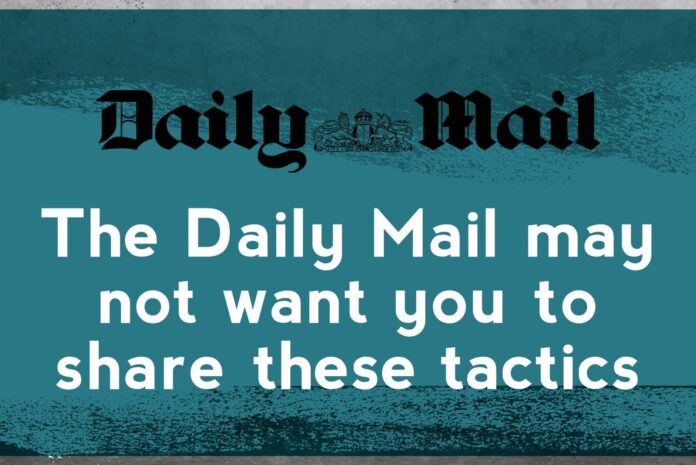A new guide from Stop Funding Hate and Ethical Consumer explains how you can help make hate unprofitable.
Some UK publications are using hateful content to generate sensationalist stories, increase sales and push social division. Advertisers are a major part of their business model, providing up to half of many companies’ revenues. With hate crime on the rise in the UK, we can make hate unprofitable by persuading advertisers to pull their support from these publications.
Together with Stop Funding Hate, we are launching a new set of guides showing how you can help stop the hate and social divisiveness present in our media, either as an individual or as an organisation or campaign group.
Since its launch in 2016, Stop Funding Hate has:
- Persuaded hundreds of advertisers to move their advertising budgets away from hateful media.
- Seen two national papers, with an average monthly reach of over 36 million people, review their approach to hate speech.
- Seen the number of anti-migrant front pages in the Daily Express fall from 70 in 2016 to 0 in 2018.
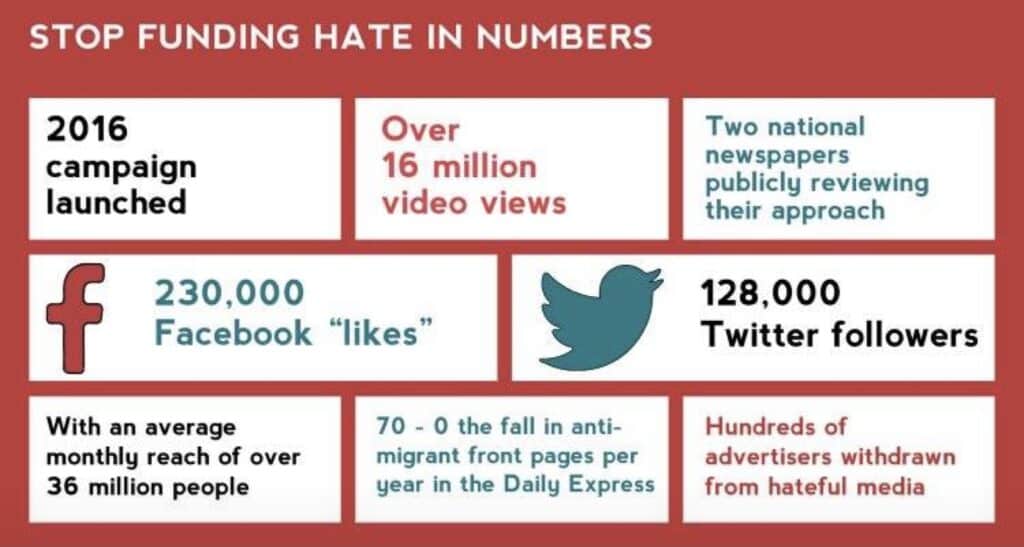
But there is still a way to go. Hate is growing and we need to stop it.
Without funding, media outlets cannot continue to pump out hateful content. Here, we provide a short guide on #HowToStopHate.
How to challenge media hate
UK newspapers and media outlets often run adverts alongside hateful content often without the advertiser even knowing. By contacting the advertiser, you can send a strong message to companies that they should not be supporting hate speech – and to the publisher that hate is not profitable.
We suggest just six steps to start challenging hate you find in the media:
- Find an advertiser/company on the page.
- Take a screenshot of the advertiser.
- Write a polite message to the company
- Contact them, via social media email or post
- Wait…
- Share!
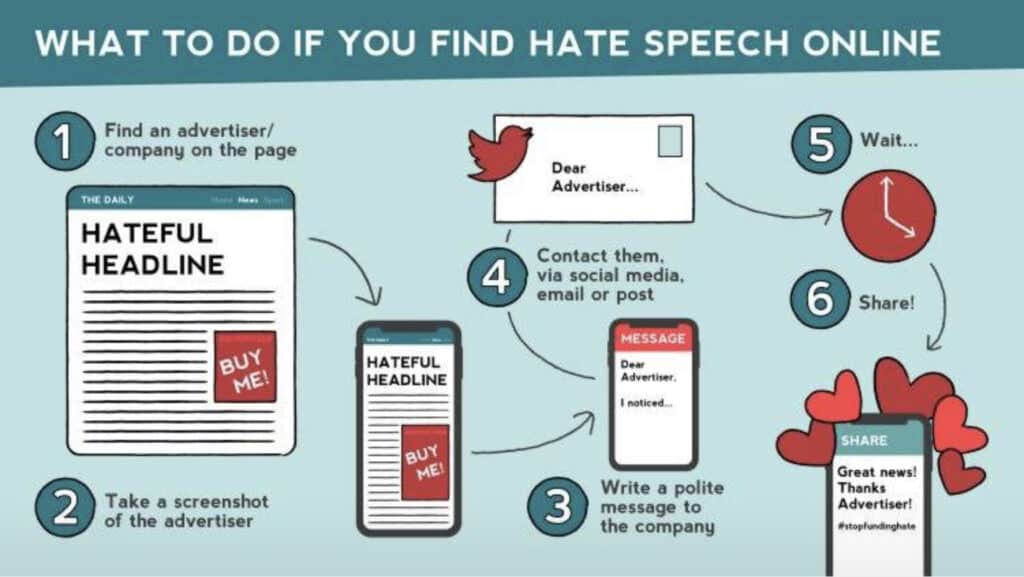
How to spot hate speech
The first step in persuading companies to stop funding hate is to identify hateful content and find the advertiser on the channel or page. Choosing the most evident and extreme examples will ensure brands do not want to be associated.
- Demonisation – characterising the group as ‘aggressive’, ‘dirty’ or ‘criminal’ or in other negative terms.
- Incitement to violence – calling for the target group to be attacked or killed — including in coded terms, e.g. ‘they need wiping out’.
- Toxic misinformation – falsely linking the target group to violent, criminal or morally corrupt behaviour.
- Incitement to discrimination – calling for members of the target group to be denied equal treatment, e.g. to be denied voting rights.
- Dehumanisation – portraying the target group as subhuman, e.g. as ‘rats’, a ‘swarm’, ‘plague’ or ‘infestation‘.
- “Accusation in a mirror” – claiming that the target group is conspiring to attack the wider population and poses a threat.

How to write a compelling message to an advertiser
Email, post or social media are all great ways to get in touch with companies. Sometimes just a handful – or even one – well placed message can persuade a company to pull advertising.
- Make a visual link between the advertiser and the hate
When you find a company advertising alongside hate, take a screenshot or photo. Making a visual link will instantly get a brand’s attention.
- Make it personal
If you feel comfortable, speaking out can be even more compelling if you explain why you personally care about the hate. One personal message can persuade a brand to pull its ads!
- Share on social media
Sharing on social media means that others can share your post and build the pressure. Tag @stopfundinghate
- Give brands the benefit of the doubt
Many brands won’t even know where their online ads are appearing. Assuming they’re onside can therefore be very powerful: “surely (brand name) doesn’t want to be aligned with this?”
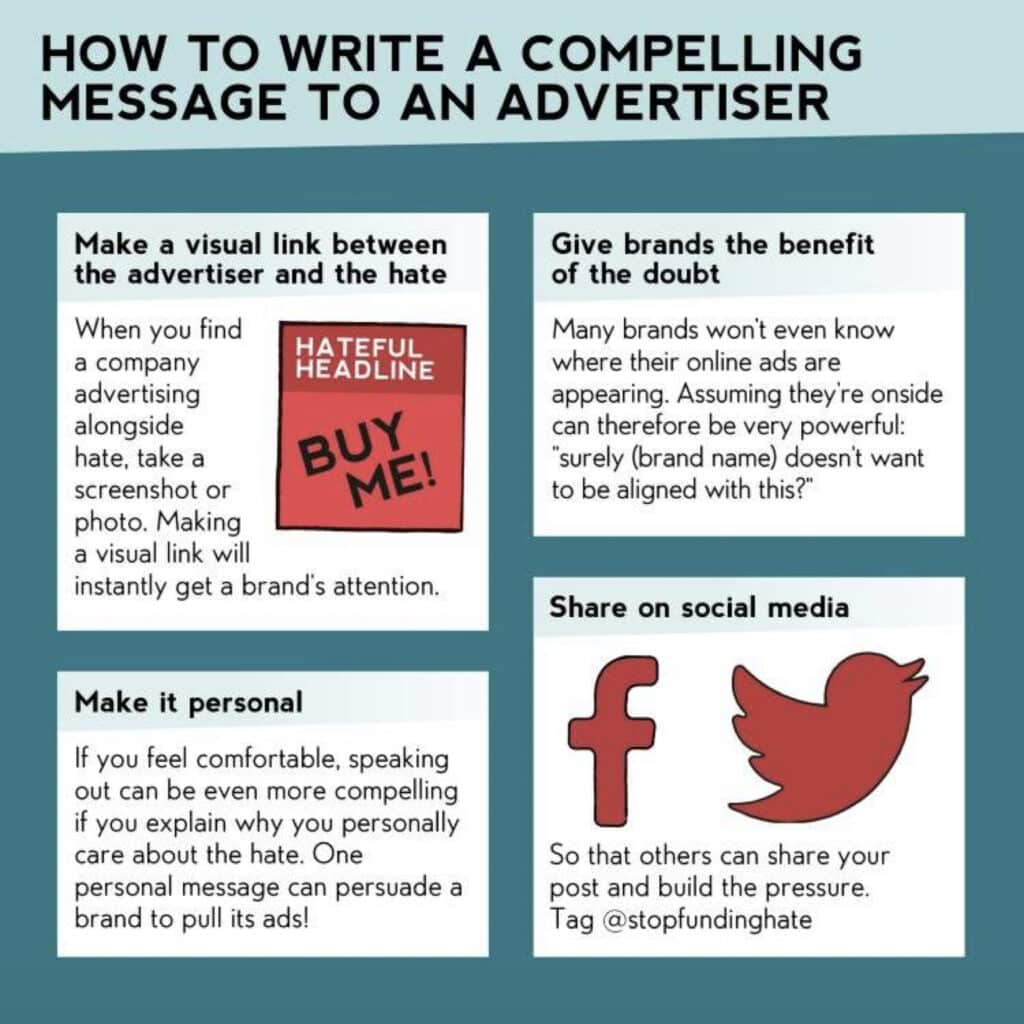
How to grow support online
Sharing your messages to companies or posting about your campaign on social media is a great way to grow the movement against hate. Twitter is an ideal space because companies’ responses are public, other supporters can join in and Stop Funding Hate supporters can help to amplify your tweets. Ask friends, family and members or organisations you’re part of to share your tweets or contact the company directly.
1. Be the change – Communicate in a non-hateful way and focus on positive change.
2. Find angles that are difficult to disagree with
3. Tap into common values that transcend the political spectrum e.g. “every life is precious”
4. Avoid arguments that help reinforce unhelpful narratives
5. Have short simple messages
6. Include an action that people can take
7. Tag relevant organisations or individuals, including @StopFundingHate and the company
8. Use hashtags for relevant topics, e.g. #StartSpreadingLove
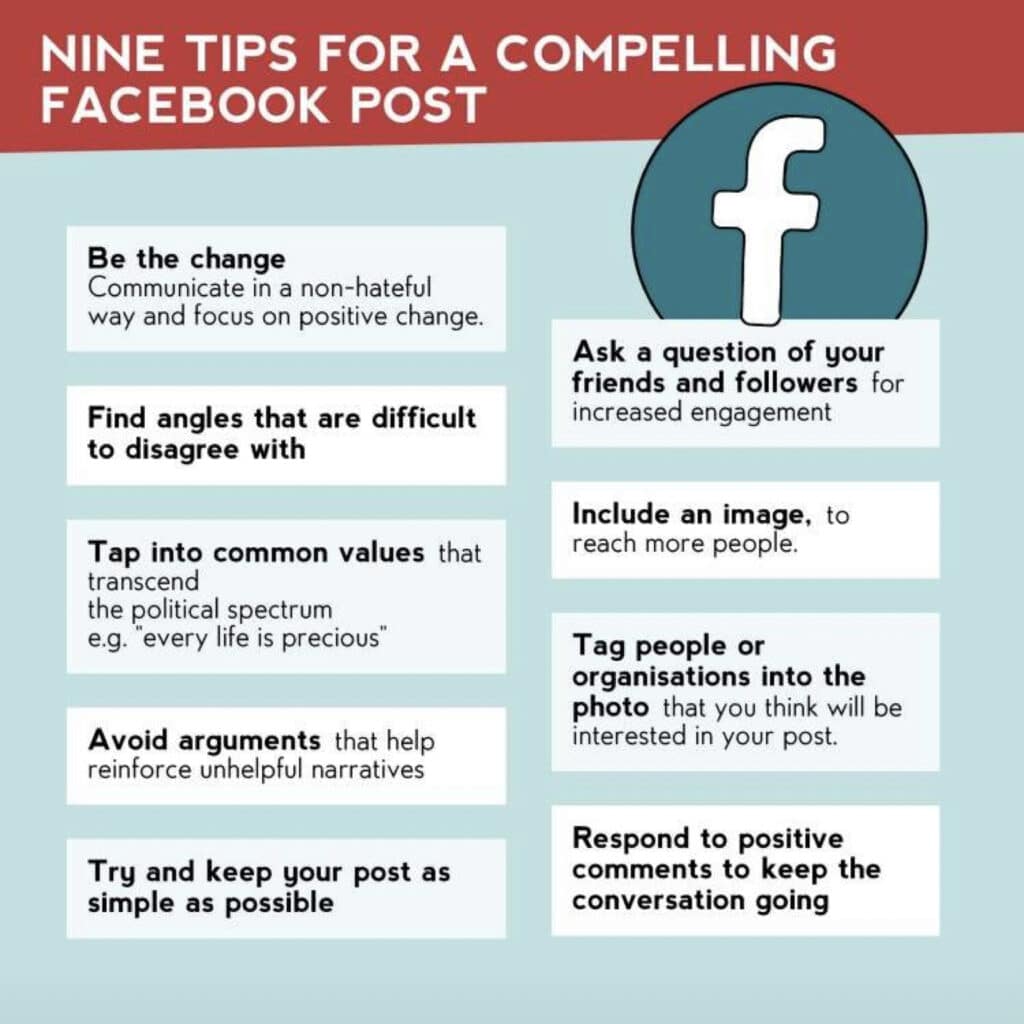
How to build a campaign group
We have also produced a special guide for campaign organisations or those looking to join with others in challenging media hate. In it, we share tips for everything from building your campaign and choosing your messaging.
- Find your power
We all have power — whether as individuals, organisers or influencers. Find the power of your organisation, whether it is your large presence on Twitter or your strong links with local community groups.
- Build a big tent
Build a broad-based, inclusive supporter community. The more supporters you have, the more opposition you can show to hateful content.
- Anchor your campaign
Founding your campaign in a clear set of principles can support you in building a large supporter base and taking a ‘be the change’ approach, modelling the inclusive example you want to see.
Check out our guide for campaign groups and organisations for more information.
Share the power
We hope that individuals and organisations all over the UK will have the tools to challenge hate every time they see it in the media.
Share our guides online using the #HowToStopHate so we can all start challenging media hate. (Use the guide for individuals or organisations and campaign groups.)
Since the launch of Stop Funding Hate in 2016, hundreds of advertisers have withdrawn from hateful media, two national newspapers have publicly reviewed their approach to hate speech and the number of anti-migrant front pages in the Daily Express has fallen from 70 in 2016 to 0 in 2018. These guides share their enormously successful tactics on #HowToStopHate so they can be used by consumers and organisations all over the UK.
Hate speech comes in many forms and targets many different groups. Over the next months, we will be working with organisations challenging Islamophobia, Traveller hate, Anti-Migrant hate, and other areas to adapt our resources, so that they are most useful to those facing hate speech in the UK as well as their allies. Look out for updates on this page for these guides.
If you like our content please keep us going for as little as £2 a month https://dorseteye.com/donate/

